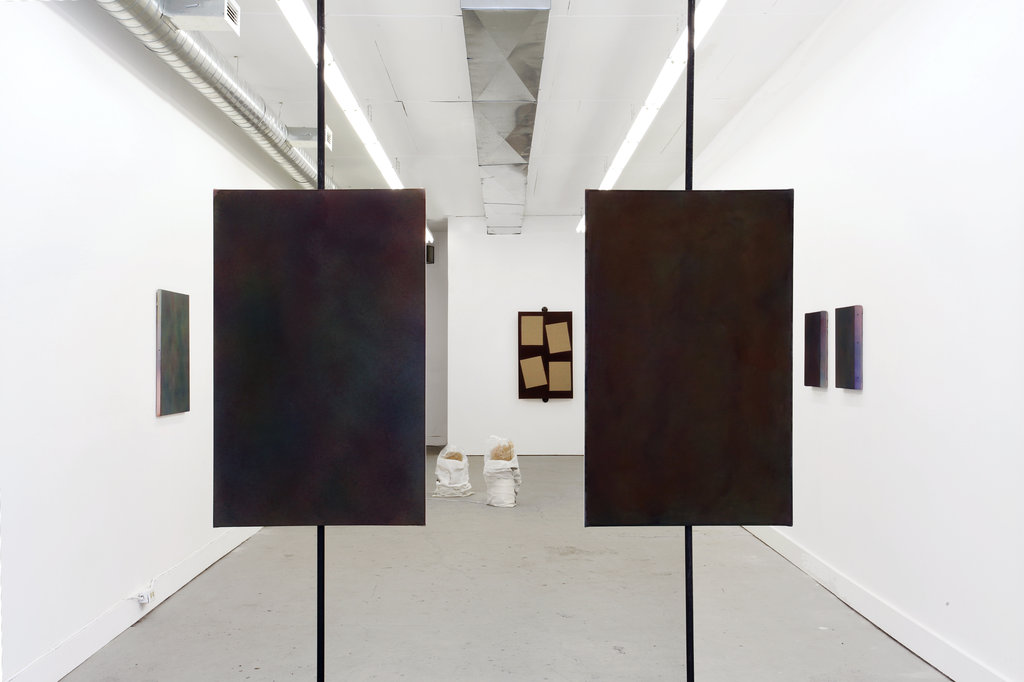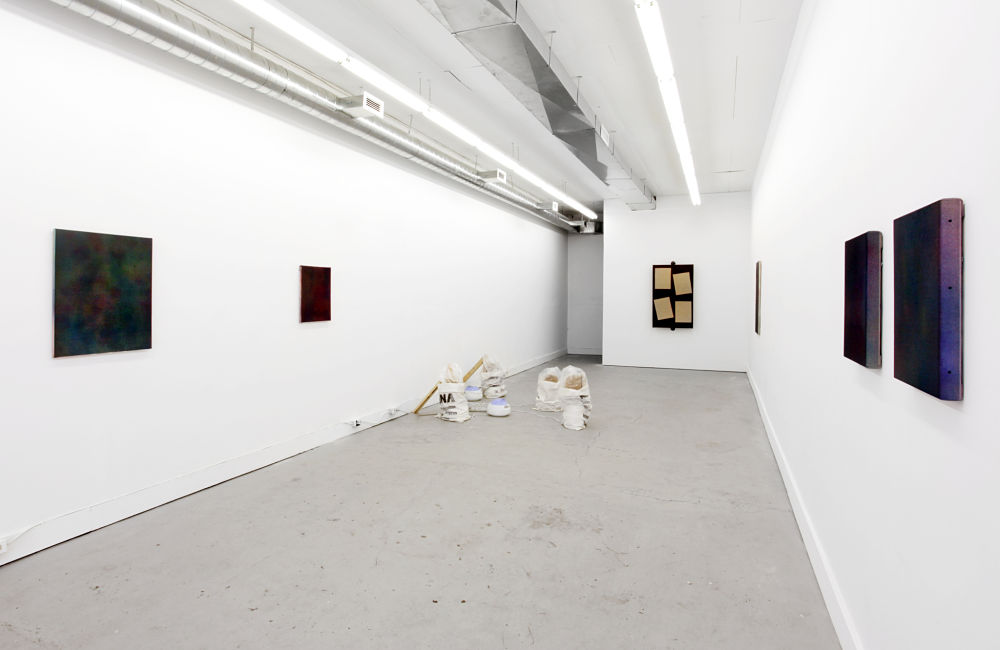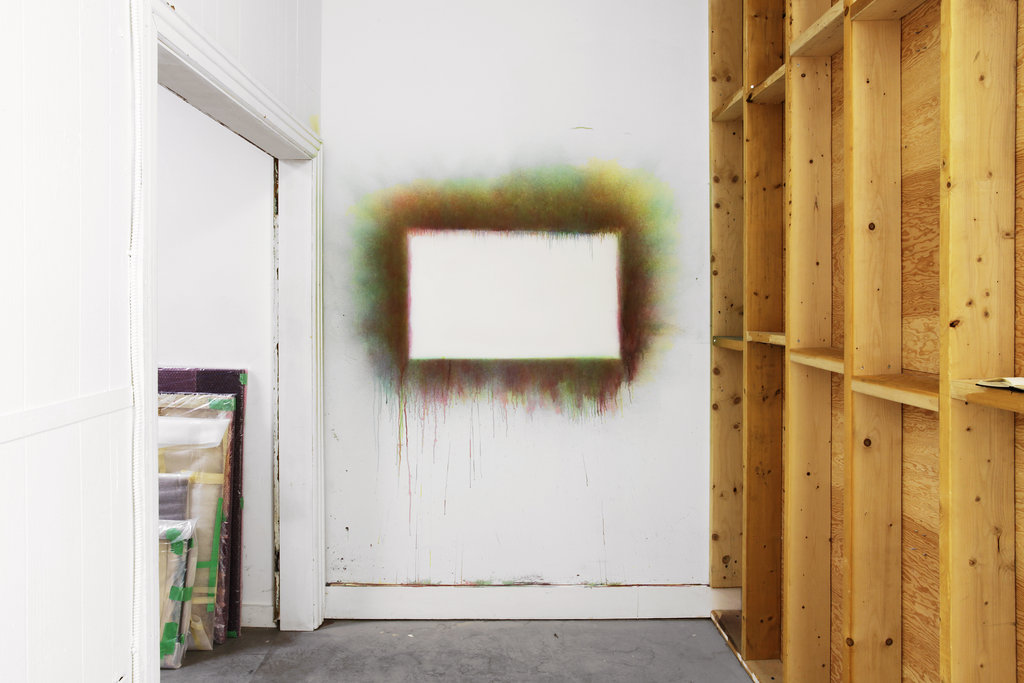 Installation view with in the foreground (left): Jon Knowles, “Roman & Williams #1”, diluted acrylic polymer on raw canvas (30″x48″), steel gasoline pipe & components, 2013, (right): Jon Knowles, “Roman & Williams #2”, diluted acrylic polymer on gessoed canvas (30″x48″), steel gasoline pipe & components, 2013. Photo: Jimmy Limit.
Installation view with in the foreground (left): Jon Knowles, “Roman & Williams #1”, diluted acrylic polymer on raw canvas (30″x48″), steel gasoline pipe & components, 2013, (right): Jon Knowles, “Roman & Williams #2”, diluted acrylic polymer on gessoed canvas (30″x48″), steel gasoline pipe & components, 2013. Photo: Jimmy Limit.
“This exhibition is about painting and art’s subsumption into the capitalist city,” says the accompanying text to the current Jon Knowles exhibition at G Gallery. The show’s bold thesis and provocative title, I’m only in it for the Manet, easily had the art writer’s attention, piquing a number of questions. How are paintings going to express the hold of capitalism on precisely themselves? And does the “Manet” of the title refer to cold money or art, or possibly both?
I enter the gallery with these questions in mind and come face to face with a pair of medium-sized monochromatic black paintings. Approaching closer, however, tints of red, green, and purple emerge out of the black surface. About half a dozen similar near-black paintings adorn the rest of the gallery walls. The surfaces of these pseudo-monochromatic paintings have a fluid and mobile quality. The hints of colour seem to float and glow amid the blackness, giving the paintings a softness that evokes the abstract canvases of Rothko and Frankenthaler.
 Jon Knowles, “Untitled #22”, diluted acrylic polymer on raw canvas, 30″x43″, 2013. Photo: Jimmy Limit.
Jon Knowles, “Untitled #22”, diluted acrylic polymer on raw canvas, 30″x43″, 2013. Photo: Jimmy Limit.
But Knowles is not exactly driven by the lofty, fuzzy notions of transcendence, intuition, and introspection of the Abstract Expressionist tradition. His paintings partake in a discursive, conceptual framework, and are rooted no so much in the imagination or the transcendental, but in the concrete material realm. The paintings can be read as a Marxist reflection on the relations of production and the material conditions of creative activity. In artist Yuki Higashino’s text commissioned to accompany the exhibition, he writes, “…if you’re an artist, art making is labour, with all its implied monetary value, exploitation and daily drudgery.” In a irreverent refusal to romanticize the artist and art-making, he concludes, “…it is imperative for artists to insist on the absence of enjoyment in their production process.”
 Installation view. Photo: Jimmy Limit
Installation view. Photo: Jimmy Limit
And hence the repetition of monochromes. Knowles exposes the subsumption of art into capitalism not through visual representation, but through the very doing of art-making itself. The practical need to produce, not some inspired urge to express, is the propelling force behind these creations. The monochromes were executed by spaying the canvas with hundreds of layers of acrylic polymer in primary colours – yellow, red, and blue, repeated over and over again until the canvas approximated black. The repetitive process comments on the daily drudgery of artistic production within a market society, while the systematic approach reflects the restraints on creative activity imposed by the economic relations overarching all social production. The messy ties between art and commerce are an old topic, but it nevertheless conjures a flood of ambivalence over the ethics of artistic production and the social role of the artist. The romanticized artist is often asked to resist, to challenge, and to revolutionize, but should we not also talk about the less glamorous hustle of everyday survival?
 Jon Knowles, “Untitled #23 (painting in-situ at G Gallery after painting in-situ at Galerie Laroche/Joncas July 2012)”, diluted acrylic polymer on gallery wall, dimensions variable, 2013. Photo: Jimmy Limit.
Jon Knowles, “Untitled #23 (painting in-situ at G Gallery after painting in-situ at Galerie Laroche/Joncas July 2012)”, diluted acrylic polymer on gallery wall, dimensions variable, 2013. Photo: Jimmy Limit.
Knowles’ work conceptually attempts to collapse a long history of painting into its essentially material grounds, where art-making – or art work – is just a node in the social relations of production. The show dismantles the fetishization of art-creation, but it is unclear if we are just left at a dead-end with some monochrome paintings for company. Is the negation of enjoyable art-making simply a pessimistic commentary on the submission of Art at the feet of advanced capitalism, leaving us with nowhere to go? Or does Knowles’ critique open up alternative possibilities for working artists within existing social structures? His future projects will perhaps shed light on new ways to bring enjoyment back into art production.
Amy Luo
*Note: The show is open July 5 – August 10, 2013 at G Gallery, 134 Ossington Street. Gallery Hours: Thursday – Saturday, 12 – 5 p.m.
